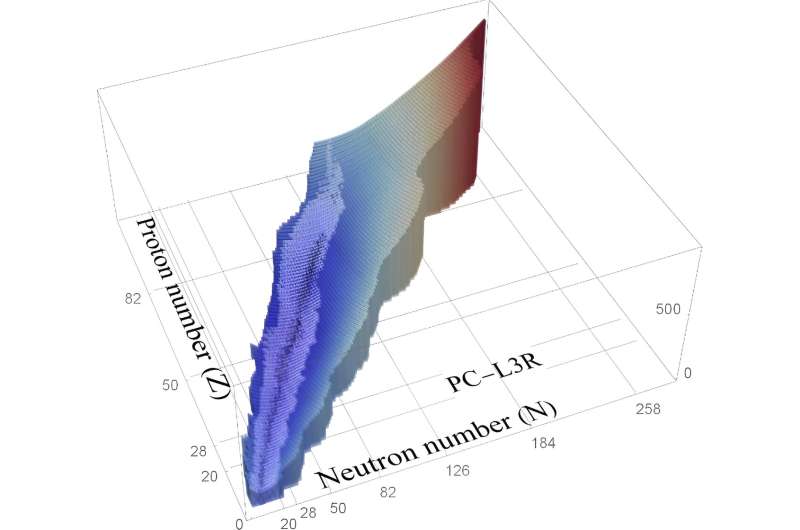This article has been reviewed according to Science X's editorial process and policies. Editors have highlighted the following attributes while ensuring the content's credibility:
fact-checked
trusted source
proofread
New approach to predict properties of undiscovered nuclei and border of nuclear landscape

With new generation radioactive-ion beam facilities, previously challenging experiments can be conducted for discovering new isotopes and for revealing physics related to the exotic nuclei far from the β-stability valley, which deepens the understanding of the origins of the chemical elements in the universe.
Researchers from the Institute of Modern Physics (IMP) of the Chinese Academy of Sciences (CAS), collaborating with Technische Universität München, predicted the existence of the exotic nuclei using the covariant density functional theory. The study was published in Atomic Data and Nuclear Data Tables.
To confirm the existence of newly discovered isotopes and the limit of an isotopic chain, the nuclear masses, radii, half-lives of these isotopes need to be determined. A set of reliable theoretical predictions of the characteristics (physics properties) of new isotopes serves as a guideline.
Measuring the last bound nuclei of isotopic chains not only examines the nuclear theory, but also advances the understanding of the extent of nucleosyntheses (syntheses of chemical elements) at the extreme astrophysical environment during neutron star mergers, core-collapsed supernovae, and X-ray bursts.
The covariant density functional theory is one of the most successful approaches for studying the nuclear structure. The theory describes the interactions among nucleons in the nuclear medium.
Nucleon-nucleon interactions can be described in the form of either point-coupling interaction (assuming nucleons as point-like particles interacting with one another) or meson-exchange interaction (assuming nucleons as some constituents communicating with one another by passing the messengers—mesons).
In this study, researchers plugged in one of these interactions to the relativistic Hartree-Bogoliubov approach to systematically explore the ground state properties of all isotopic chains from oxygen to darmstadtium.
These properties consist of the binding energies, one-neutron and two-neutron separation energies, root-mean-square radii of matter, of neutron, of proton and of charge distribution, Fermi surfaces, ground-state spins and parities.
"In fact, exotic nuclei that potentially exhibit new phenomena provide a testing ground for our understanding of quantum many-body system. The existence of about 2,500 nuclides has been experimentally proven. We expect new facilities promising in discovering more exotic nuclei and unraveling the phenomena that we have never seen before. Matching theoretical predictions with experimental findings could be exciting for us to cross-check our theoretical models," said Liu Zixin from IMP, the first author of the paper.
Based on these ground-state properties of nuclei, the drip line of neutron and proton, halo phenomenon, and new magic number problem were discussed in detail. The predicted properties can provide guidance for future experiments and theoretical research in nuclear physics.
More information: Zi Xin Liu et al, Nuclear ground-state properties probed by the relativistic Hartree–Bogoliubov approach, Atomic Data and Nuclear Data Tables (2024). DOI: 10.1016/j.adt.2023.101635
Provided by Chinese Academy of Sciences





















